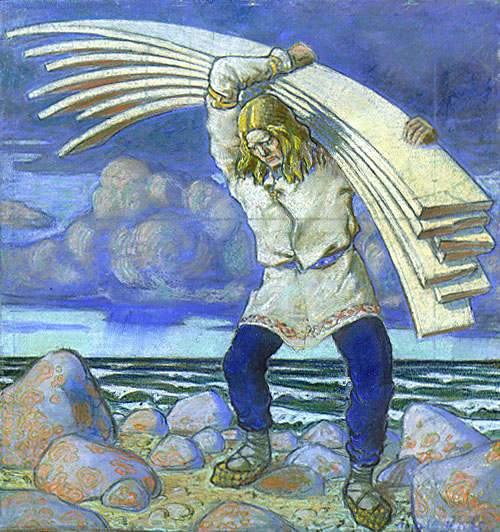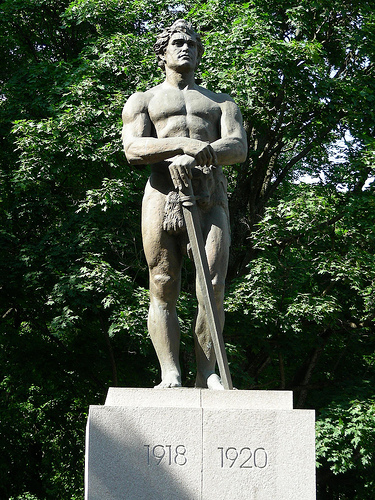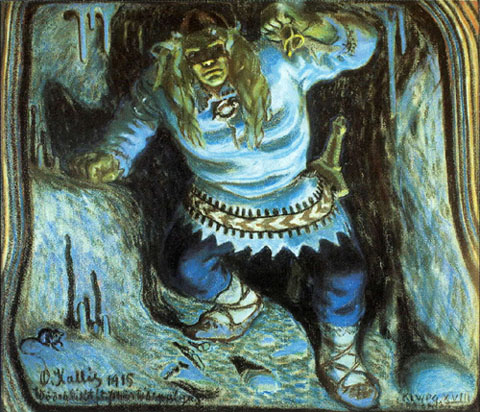|
A
messenger comes to the Kalevide and informs him of a battle against his people.
z
Canto X. - The heroes and the
Water-Demon
While
the Kalevide and his cousin Alevide are walking through the country they come
across a pair of demons arguing over the ownership of a pool. The Alevide drains
the pool, but the host water-demon asks him to desist. The Alevide tricks the
water-demon out of his riches.
The
Alevide sends his cousin’s servant to the water-demons lair. He is teased and
runs away. The Kalevide wrestles the water-demon and wins.
The
Kalevide decides to fortify towns for protection; he goes to Lake Peipus to
fetch wood. He meets the Air-maiden in a well.
z
Canto XI. - The loss of the sword
The
Kalevide walks across Lake Peipus but a sorcerer spies him and decides to drown
him. His efforts fail.
The
sorcerer steals the Kalevide’s sword. After an attempt to take it away, he is
forced to drop it in a stream. When the Kalevide awakes he goes hunting for his
sword. When he finds it, he consults it and finds it is happier in the stream.
He leaves it there, but orders it to cut off the legs of the sorcerer should he
ever return.
The
Kalevide carries on in this journey and meets a man of human stature who regales
him with a story of giants. The Kalevide is amused and offers his protection. He
places the man in his wallet.
z
Canto XII. - The fight with the
sorcerer’s sons
The
three sons of the sorcerer attack the Kalevide while he is walking on his way.
He fights hard but gains no ground until he hears and heeds the advice of a
small voice from the underbrush. He defeats the sorcerer’s sons and asks his
helper to show himself. After some persuasion, his helper comes out of the
underbrush and the Kalevide cuts some of his coat for the small creature to
cover himself up, but only cuts enough to cover his back.
The
Kalevide discovers that man in his wallet is dead and grieves. He falls asleep
and is enchanted by the sorcerer. He sleeps for 7 weeks and dreams about
Ilmarine’s workshop.
z
Canto XIII. - The Kalevide’s first
journey to Hades
On
his return journey, the Kalevide sees demons cooking at the entrance to a cave.
He enters the cave and finds the palace of Sarvik. He breaks in and meets 3
maidens.
The
Kalevide and the maidens talk and they give him a magic hat and rod. He promises
to free them from Sarvik and find them husbands.
z
Canto XIV. - The palace of Sarvik
The
3 maidens show the Kalevide around Sarvik’s palace. It is an intricate and
massive castle. They confess that they are immortal and ever radiant, but they
are unhappy and have no joys in life. The Kalevide tells them he will rescue
them and he makes plans to wrestle with Sarvik. The 2 oldest maidens switch
Sarvik’s magical liquors so he will be weakened when he drinks. The Kalevide
uses the magic hat to make himself appear smaller.
When
Sarvik returned, he demanded the Kalevide explain himself. Kalevide makes his
challenge and the 2 combatants wrestle viciously. When they stop for a rest, the
Kalevide uses the hat to regain his old size and strength and bashes Sarvik into
the ground.
The
Kalevide and the maidens flee from Sarvik’s palace. The Kalevide burns the
magic hat much to the distress of the maidens.
z
Canto XV. - The marriage of the
sisters
The
maidens and the Kalevide are chased by demons. The youngest maiden uses the
magic rod to create a torrent of water and a bridge to take them to safety.
Tühi
questions the Kalevide about his visit to Põrgu and his fight with Sarvik, the
Kalevide answers sarcastically.
The
maidens are married to Alev and Sulev but the second maiden is kidnapped by a
sorcerer. The hunt for her, kill the sorcerer and recover her, she is married to
Olev.
z
Canto XVI. - The voyage of the
Kalevide
The
Kalevide ponders a voyage to the end of the world. A great ship called Lennuk is
created.
The
Kalevide meets a Laplander called Varrak who tells him that the end of the world
is not reachable. He offers to take them home. The Kalevide says he needs no
help to return home but would be grateful if Varrak would take them to the
world’s end. The voyage to an island of fire, steam and smoke where the
Sulevide gets scorched.
They
are found by a giant child who carries them to her father. The father requests
that they solve his riddles for their release. They are successful and the
daughter takes them to their boat and blows them out to sea.
The
group carries on in its journey north. They witness the northern lights and
eventually come to an island of dog men. After some troubles, peace is made with
the dog men and the leader of them tells the Kalevide that he has wasted his
time. The Kalevide finally decides to go home.
z
Canto XVII. - The heroes and the
dwarf
Magnificent
fortified cities have been built by Olev. The Alevide and the Sulevide have also
built fine cities. The Kalevide names Olev’s city after his mother, Lindanisa
(modern day Tallinn).
News
of a great invasion force reaches the Kalevide and he sets of to fight in a long
pitched battle, during which he loses his horse in the sheer depth of gore
created during the battle.
After
the battle is over and the spoils handed out, the Kalevide and his friends set
out to find further invaders. They come across an old woman cooking and settle
down for the night.
During
the night a dwarf appears and asks each of the heroes if he can take a sip from
the pot of soup the old woman was cooking. All but the Kalevide allow him to and
he proceeds to drink the whole pot, grow to the sky then vanish.
After
the dwarf has appeared to all of the heroes the daughters of the Meadow Queen
dance and sing and tell the tale of adventures still to come to the Kalevide.
z
Canto XVIII. - The Kalevide’s
journey to Põrgu (Hell)
The
Kalevide wakes in the night and finds the gates to Põrgu. He enters and
proceeds into the depths of hell itself, aided by creatures along the way.
The
Kalevide comes across a large iron bridge and the huge army of Sarvik. He
battles hard and eventually gets over the bridge to the palace of Sarvik. He
beats his way in and is greeted by a vision of his mother and Sarvik’s mother.
z
Canto XIX. - The last feast of the
heroes
The
Kalevide and Sarvik have a lengthy wrestling match in which the Kalevide
prevails. He binds Sarvik heavily with chains, takes a small treasure and leaves
for the world of men.
The
Kalevide and his friends have a meal of ox, which the Alevide was able to kill.
The
Kalevide and his friends return to Lindanisa and a great feast and drinking bout
begins. Many songs are sung and much joy is in the air. There is news of yet
another invasion from all sides of the country by many enemies.
Varrak
departs for Lapland, taking with him a book of wisdom, given to him by the
Kalevide, much to the dismay of the sons of Olev and Sulev.
Many
refugees arrive with news of the impending battles. The Kalevide consults his
Father’s grave, but no answer comes.
z
Canto XX. - Armageddon
The
Kalevide and his friends prepare for war. The Kalevide buries his treasure and
protects it with incantations to Taara.
The
Kalevide and his friends engage in a fierce battle that lasts many days and in
which the Kalevide loses his horse and the Sulevide is badly injured. The
Sulevide eventually dies.
Olev
builds a large bridge over the river Võhanda and the army proceeds over to
engage the remaining enemy. The battle rages hard for many days until the heroes
are exhausted and decide to take a drink. The Alevide slips and falls into the
lake and drowns.
The
Kalevide is so grief-stricken he abdicates and places his kingdom in the hands
of Olev. The Kalevide leaves for a peaceful life on the banks of the river Koiva.
He does not get the peace he desires and is annoyed by many visitors, some
aggressive. He wanders around the country annoyed by these intrusions and makes
his way to Lake Peipus. He wades into Käpä, the brook where his old sword lay,
and the sword keeps its promise to cut off the legs of anyone who dares wade in
the brook. Unfortunately the Kalevide had forgotten this promise and his legs
are cut off.
The
Kalevide dies and is taken to heaven. However, he is deemed too valuable and is
reanimated in his old body to stand guard for eternity at the gates of Põrgu to
keep watch on Sarvik and his demons. He is there still tied to the gates of
Põrgu by his hand, which is locked in a rock.
|


